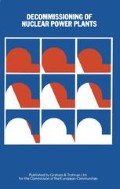Summary
In order to reduce radiation exposure and occupational hazards during decommissioning tasks in nuclear facilities, and to allow intervention at an early stage after shutdown and in situation of accident, remotely controlled and, during execution of specific operations, autonomous systems are needed.
This paper presents the results of two research programs on the subject of remote operation and robotics.
One of these programs, “Review of Systems for Remotely Controlled Decommissioning Operations”, conducted in close cooperation by GST and ACEC, was aimed at analyzing the tasks arising, at the review of applicable existing equipment and first conceptual studies of needed remotely operated equipment.
Based on the evaluation of tasks and existing equipment, recommendation for future research and development was made.
The second program, “Possible Advances in Remotely Controlled Operations in Hostile Environments”, conducted by the University of Warwick, concentrates mainly on advanced control and data transmission systems.
This study reviews the present state-of-the-art in remote controlled robotics (REMCON) and gives total systems predictions for possible future applications within the nuclear industry.
In decommissioning tasks, the main fields of application to be considered are: monitoring by visual inspection and radiation or position measurement, decontamination of assemblies or of work space, dismantling of metal or concrete structures, and possibly treatment and transport of resulting debris.
It is clear that in terms of human life and health, the use of remote control or robotic devices in nuclear industry in general, and in decommissioning tasks in particular, is a necessity.
Results of both studies confirm that most of the technologies needed to develop future REMCON systems exist as of today. In fact, with the exception of control aspects, the technology requirements are not excessive.
The main problem lies in the necessity for a totaly new systems approach to be developed. An approach involving the marriage of two high level technologies, namely robotics and nuclear.
In other words, to start a coherent program of development for REMCON, we need to foresee in sufficient detail both the application problem areas and the robotics potentials and problems.
Access this chapter
Tax calculation will be finalised at checkout
Purchases are for personal use only
Preview
Unable to display preview. Download preview PDF.
Author information
Authors and Affiliations
Editor information
Editors and Affiliations
Rights and permissions
Copyright information
© 1984 ECSC, EEC, EAEC, Brussels and Luxembourg
About this paper
Cite this paper
da Costa, L. et al. (1984). Remote Operation in Decommissioning. In: Schaller, K.H., Huber, B. (eds) Decommissioning of Nuclear Power Plants. Springer, Dordrecht. https://doi.org/10.1007/978-94-009-5628-5_25
Download citation
DOI: https://doi.org/10.1007/978-94-009-5628-5_25
Publisher Name: Springer, Dordrecht
Print ISBN: 978-94-010-8983-8
Online ISBN: 978-94-009-5628-5
eBook Packages: Springer Book Archive

